Catégories
Documents disponibles dans cette catégorie (424)
 Ajouter le résultat dans votre panier Affiner la recherche
Ajouter le résultat dans votre panier Affiner la recherche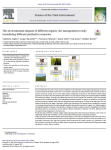
Article
V. Vaglia ; J. Bacenetti ; F. Orlando ; S. Alali ; E. Bosso ; S. Bocchi |Rice cultivation has a key role in food security worldwide; on the other hand, it has a high potential impact on the environment and human health, mainly due to the extensive pesticides use and greenhouse gas emissions caused by flooded cultivat[...]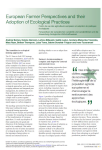
Article
A. Barnes ; H. Hansson ; L. Billaudet ; G. Leduc ; G.M. Tasevska ; M. Ryan ; B. Thompson ; L. Toma ; S. Duvaleix-Tréguer ; I. Tzouramani |Delivering an agricultural policy which meets ecosystem and climatic pressures and addresses weaknesses in our current food system presents complex challenges for food producers. Adoption of ecological practices will reduce the dependence on imp[...]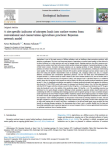
Article
Agriculture is one of the main sources of diffuse pollution, such as fertilisers, plant protection products, solid particles or pathogens. The short- and long-term impact of agriculture on surface water quality is often driven by on-farm decisio[...]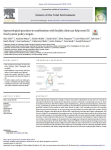
Article
E. Roose ; A. Mayer ; A. Muller ; G. Kalt ; S. Ferguson ; K.-H. Erb ; R. Hart ; S. Matej ; L. Kaufmann ; C. Pfeifer ; A. Frehner ; P. Smith ; G. Schwarz |Agroecology has been proposed as a strategy to improve food system sustainability, but has also been criticised for using land inefficiently. We compared five explorative storylines, developed in a stakeholder process, for future food systems in[...]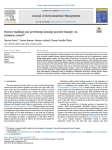
Article
P. David ; C. Roemer ; R. Anibaldi ; S. Rundle-Thiele |With environmental degradation reaching emergency levels, urgent action for preventable behaviours is needed. There is limited scientific evidence available indicating key success factors that can be implemented to support lasting farming practi[...]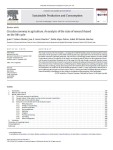
Article
The circular economy (CE) has emerged as a strategy able to fulfil the double purpose of improving the economic performance of the agricultural activity while minimising the impact generated on the environment by reducing the inflow of resources[...]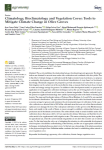
Article
A. Cano-Ortiz ; J.C. Fuentes ; F.L. Gea ; J.M. Ighbareyeh ; R.J. Quinto Canas ; C.I. Meireles ; M. Raposo ; C.J. Gomes ; G. Spampinato ; S. del Río González ; C.M. Musarella ; E. Cano |This work establishes the relationship between bioclimatology and agronomy. Bioclimatic indices are obtained for several areas under olive cultivation and correlated with olive yields. Due to the effect of climate change on cultivation and the h[...]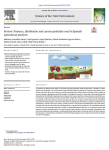
Article
To guarantee an adequate food supply for the world's growing population, intensive agriculture is necessary to ensure efficient food production. The use of pesticides helps maintain maximum productivity in intensive agriculture by minimizing cro[...]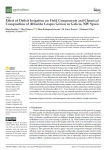
Article
In the context of climate change, water management is crucial for controlling the reproductive growth and quality of grapes. In this study, we aim to determine the effects of different water regimes on the yield components and chemical compositi[...]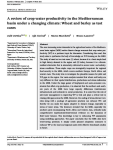
Article
Z. Unnisa ; A. Govind ; M. Marchetti ; B. Lasserre |The ever-increasing water demands in the agricultural sector of the Mediterranean basin region (MBR) under climate change warrants that crop water productivity (WP) is a pertinent topic for discussion. Considering this need, this study aims to s[...]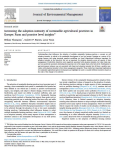
Article
B. Thompson ; A.P. Barnes ; L. Toma |Understanding what influences the adoption of multiple sustainable farming practices, a concept we call adoption intensity, is critical to the sustainable development of our food system. Drawing on a survey of European farmers, and using structu[...]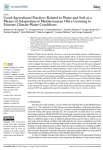
Article
N.N. Kourgialas ; G. Psarras ; G. Morianou ; V. Pisinaras ; G. Koubouris ; N. Digalaki ; S. Malliaraki ; K. Aggelaki ; G. Motakis ; G. Arampatzis |Despite the fact that the olive tree is one of the best-adapted species in Mediterranean hydroclimate conditions, climate extremes impose negative effects on olive fruit set and development and subsequently on crop yield. Considering that the fr[...]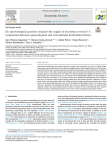
Article
Agricultural intensification has strongly impacted ecosystems and accelerated the process of global change. Consequently, agroecological practices are being increasingly adopted. Agroecological practices are biodiversity-based solutions that aim[...]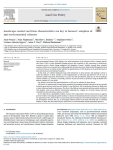
Article
A. Paulus ; N. Hagemann ; M.C. Baaken ; S. Roilo ; V. Alarcón-Segura ; A.F. Cord ; M. Beckmann |Agri-environmental schemes (AES) belong to the main instruments of the European Union's Common Agricultural Policy (CAP) to foster sustainable farming practices that contribute to the conservation of biodiversity, ecosystem services, climate cha[...]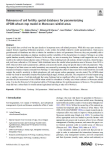
Article
A. Mamassi ; H. Marrou ; M. El Gharous ; J. Wellens ; F.-E. Jabbour ; Y. Zeroual ; A. Hamma ; B. Tychon |Crop models have evolved over the past decade to incorporate more soil-related processes. While this may open avenues to support farmers regarding fertilization practices, it also widens the pitfalls related to model parametrization. Open-access[...]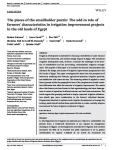
Article
M. Salman ; I. Ferto ; E. Pék ; I.A. El-Desouky ; S. Zaki ; R. Darwesh ; F. Lebdi ; Q. Alali |Irrigation development is essential for reducing vulnerability to water resource scarcity, food insecurity, and climate change impacts in Egypt. The centralized irrigation development must, however, overcome the challenges of the diversity of sm[...]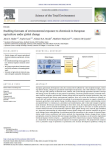
Article
J.D. Hader ; T. Lane ; A.B.A. Boxall ; M. MacLeod ; A. Di Guardo |European agricultural development in the 21st century will be affected by a host of global changes, including climate change, changes in agricultural technologies and practices, and a shift towards a circular economy. The type and quantity of ch[...]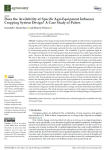
Article
Cropping system design is being transformed through the twofold evolution of agricultural practices for an agroecological transition, and of equipment diversification for agrotechnical needs. Among the most well-known drivers there are genetic s[...]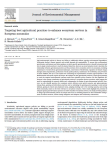
Article
Agri-environmental policies in Europe are failing to sufficiently address ongoing environmental degradation, biodiversity decline, climate impacts, and societal demands for sustainability. To reverse this, policymakers, practitioners, and farmer[...]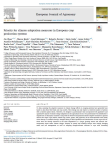
Article
J. Zhao ; M. Bindi ; J. Eitzinger ; R. Ferrise ; Z. Gaile ; A. Gobin ; A. Holzkämper ; K.-C. Kersebaum ; J. Kozyra ; Z. Kriauciuniene ; E. Loit ; P. Nejedlik ; C. Nendel ; Ü. Niinemets ; T. Palosuo ; P. Peltonen-Sainio ; V. Potopová ; M. Ruiz-Ramos ; P. Reidsma ; B. Rijk ; M. Trnka ; M.K. van Ittersum ; J.E. Olesen |To date, assessing the adaptive measures to climate change effects on cropping systems have generally been based on data from field trials and crop models. This strategy can only explore a restricted number of options with a limited spatial exte[...]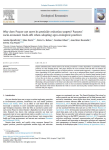
Article
A. Bjørnåvold ; M. David ; D.A. Bohan ; C. Gibert ; J.-M. Rousselle ; S. Van Passel |Despite substantial policy efforts made by the French government to reduce dependence on pesticides, farming practices are only changing slowly. This paper analyses the socio-economic trade-offs that 110 farmers are currently facing in the trans[...]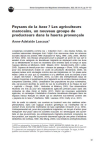
Article
La conjonction d’un système migratoire sous contrainte dans lequel sont insérés les ouvriers saisonniers agricoles marocains en France et le délaissement des espaces productifs agricoles français dans lesquels ils travaillent est à l’origine de [...]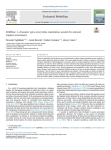
Article
F. Taghikhah ; J. Borevitz ; R. Costanza ; A. Voinov |Threats to sustainable food production are accelerating due to climate change, population growth, depletion of natural capital, and global market instability. This causes significant risks to farmers, consumers, and financial and policy institut[...]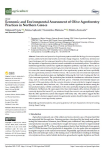
Article
Preservation and promotion of agroforestry systems entails the ideology for more ecosystem services, additional biodiversity benefits and climate change mitigation. Furthermore, farmland and forest landscapes and the consequent benefits to the e[...]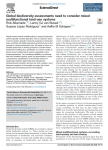
Article
Global scenario-based modelling efforts to support biodiversity policies typically consider agriculture only as a pressure factor. Current scenarios typically include the expansion of protected areas combined with higher agricultural productivit[...]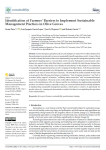
Article
Current European agriculture policies and strategies are aimed to boost the transition from the predominant conventional to a more environmentally friendly agriculture model. As part of this, it is crucial to identify the barriers that exist to [...]
Article
Many stated preference studies have shown that individuals’ attitudes play an important role in explaining their behaviour and helping to disentangle preference heterogeneity. When responses to attitudinal questions are introduced into discrete [...]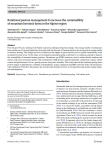
Article
S. Baronti ; F. Ungaro ; A. Maienza ; F. Ugolini ; A. Lagomarsino ; A.E. Agnelli ; C. Calzolari ; F. Pisseri ; G. Robbiati ; F.P. Vaccari |Over the past 30 years, farming in the Alpine region has undergone important changes: the average number of animals per farm and the use of external inputs have increased while the diversity of farming practices has decreased, becoming similar t[...]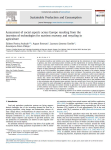
Article
The potential beneficial and harmful social impacts generated by the introduction of novel technologies, in general, and those concerning nutrient recovery and the improvement of nutrient efficiency in agriculture, in particular, have received l[...]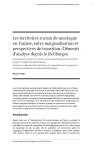
Article
En Tunisie, les territoires de montagne n’ont été que peu concernés ces dernières décennies par les politiques de développement rural et agricole. En outre, ils n’ont été que partiellement abordés dans les productions scientifiques qui, souvent,[...]









